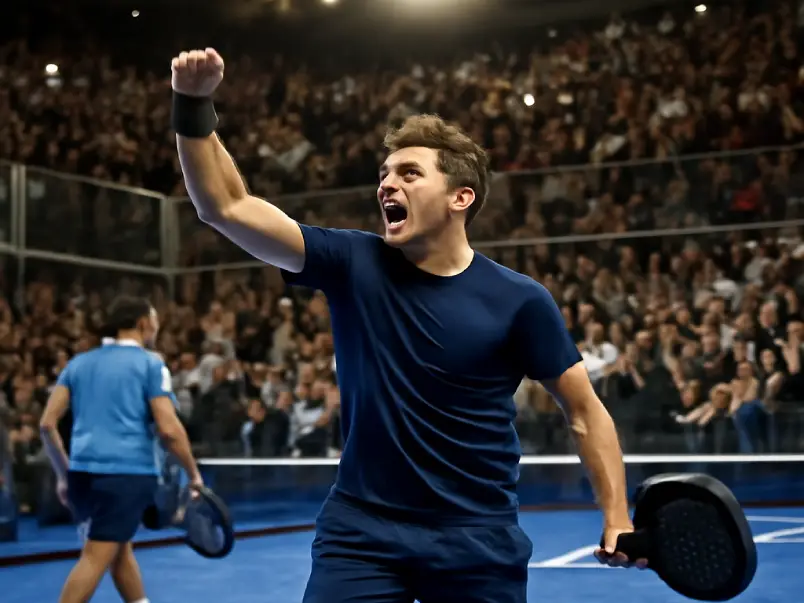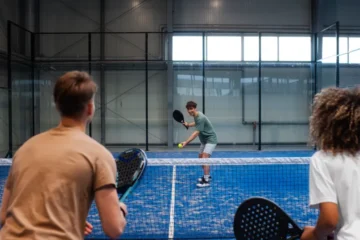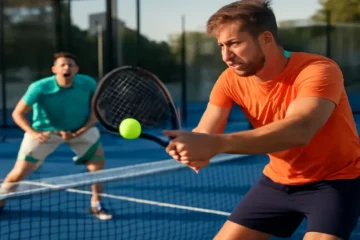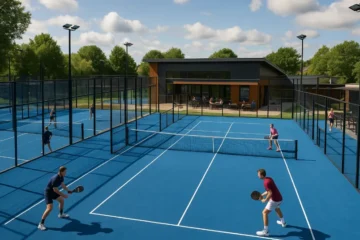Imagine the electric atmosphere of a major padel final, where the crowd’s cheers reverberate off the walls and the intensity of the match grips everyone’s attention. The energy is palpable, and the question lingers in the air: “When will we see this on the Olympic stage?”
Padel, a sport that blends the dynamics of tennis and squash, has been rapidly growing in popularity across the globe. From its roots in Spain to becoming a phenomenon in countries around the world, padel’s rise is one of the most remarkable stories in sports. With an expanding fan base, professional tours, and backing from high-profile endorsements, it’s no wonder that padel is now eyeing a coveted spot on the Olympic Games program.
This article delves into the latest developments surrounding padel’s journey to becoming an Olympic sport, the hurdles it faces, and the realistic timeline for its inclusion in the Games.
What is Padel? A Quick Primer for the Uninitiated
The “What”
Padel is a fast-paced racket sport that combines elements of tennis and squash. It’s typically played in doubles, on a court surrounded by glass walls, which allows the ball to bounce off them like in squash. Players use solid rackets, without strings, and the game is played with a smaller ball similar to a tennis ball but with less pressure. The rules are a mix of tennis and squash, creating an exciting and dynamic sport.
While the sport’s structure is easy to understand, its charm lies in its accessibility. Padel is easier for newcomers to pick up compared to other racket sports, especially tennis, thanks to its smaller court and the bounce-off-the-walls mechanic, which adds strategy without overwhelming beginners.
Why It’s Booming
Padel’s rapid rise in popularity can be attributed to several factors:
- Social Nature: Padel is often seen as a more social sport compared to tennis or squash. The doubles format encourages teamwork, and the enclosed court fosters a fun, interactive environment for players.
- Shorter Learning Curve: Unlike tennis, which can take years to master, padel can be picked up relatively quickly, making it an attractive option for casual players and families.
- Celebrity Endorsements: High-profile celebrities, including former world number one tennis players like Rafael Nadal and Novak Djokovic, have endorsed padel, helping it gain visibility.
- Major Investments: The sport has attracted significant investment in infrastructure, from padel courts to professional tournaments, helping it become a more global phenomenon.
Global Expansion
The global growth of padel is undeniable. With more than 20 million players worldwide, the sport has found a home in regions outside of Europe, including Latin America, the Middle East, and even parts of Asia and North America. As the sport continues to expand its reach, its appeal to both grassroots players and top professionals becomes undeniable.
The Current Status: Where Does Padel Stand with the IOC?
Official Recognition
In 2023, the International Padel Federation (FIP) achieved a significant milestone: it was granted provisional recognition by the International Olympic Committee (IOC). This is a crucial first step in the long journey toward Olympic inclusion.
While provisional recognition is an important achievement, it’s not an immediate guarantee that padel will be included in the Olympic Games. However, it does mark the beginning of the pathway to potential Olympic status. This recognition provides the FIP with the following:
- Official Status as an Olympic Federation: The FIP is now on the IOC’s radar, allowing it to participate in Olympic-related discussions and negotiations.
- Access to Funding and Development Support: The IOC’s support offers funding and resources to help develop the sport globally, which is critical to its future inclusion in the Games.
- A Long Road Ahead: Provisional recognition is not the end goal; it’s just the beginning. The FIP must meet additional criteria and navigate a complex approval process to earn full recognition and eventually make it into the Olympics.
The Latest Updates & Key Milestones
The 2028 Los Angeles Olympics “Miss”
Unfortunately for padel enthusiasts, padel will not be included in the sports program for the 2028 Los Angeles Olympics. While the sport was part of the conversation and lobbying efforts, it ultimately did not make the cut. This was a significant blow, but it’s not the end of the story.
The Focus is Now on Brisbane 2032
Eyes are now set on Brisbane 2032, where padel’s chances of inclusion are much higher. The FIP, alongside the broader padel community, is actively working toward securing a place for the sport in these Games. The momentum for padel’s inclusion is strong, and the 2032 Games are seen as a more realistic opportunity.
Recent High-Level Lobbying
Efforts to get padel into the Olympics have included numerous high-level meetings between FIP leadership and the IOC. These discussions have been aimed at highlighting the sport’s global appeal and growing fan base.
The FIP has also held events like the “Olympic Padel Week”, which showcased the sport to IOC members and demonstrated its potential as an Olympic sport.
Meanwhile, padel’s professional circuits, like Premier Padel, continue to grow, providing a clear indication to the IOC of the sport’s stability, professional appeal, and widespread popularity.
The Pathway to the Podium: What Needs to Happen Next?
For padel to become an official Olympic sport, several key steps need to be taken. Let’s break them down:
Full IOC Recognition
The FIP must transition from provisional to full recognition by the IOC. This involves demonstrating a robust governance structure, ensuring transparency, and adhering to the IOC’s Olympic Charter. Full recognition is a significant step that would pave the way for padel’s official inclusion in the Games.
The “Olympic Program” Hurdle
Even if the FIP receives full recognition, padel must be officially proposed by the Local Organizing Committee (e.g., Brisbane 2032). The IOC’s Session will then need to approve it. The IOC has strict criteria for evaluating new sports, and the competition for spots is fierce.
Key Criteria the IOC Evaluates
- Global Popularity: While padel is already strong in Spain and Latin America, the IOC will want to see deeper global participation, including growth in regions like North America and Asia.
- Governance: The FIP must demonstrate effective governance, including solid leadership, international development programs, and adherence to IOC regulations.
- Cost and Logistics: The IOC will assess the feasibility of constructing temporary courts in Olympic venues. Padel’s existing infrastructure, with courts that can be set up in various locations, is an advantage.
- Youth Appeal: Padel’s trendy, social image makes it an appealing sport for younger generations, a key demographic the IOC targets.
- Gender Equality: Padel has a significant advantage here: the sport’s format is naturally balanced between men’s and women’s competitions, which aligns with the IOC’s commitment to gender equality.
Potential Format: What Would Olympic Padel Look Like?
If padel does make it to the Olympic Games, what would the format look like?
Likely Events
The core events would likely include Men’s Doubles and Women’s Doubles, reflecting the sport’s current structure. These events are popular in both recreational and professional levels, making them a natural fit for the Olympic stage.
Number of Athletes
Given the nature of padel, a probable Olympic tournament could feature 32 pairs (64 athletes) for each gender. This would align with the IOC’s standard for team-based sports.
Court Location
The courts would likely be placed in a central, fan-friendly location within the Olympic Park, offering easy access to spectators. Temporary courts could be set up in prime locations, allowing for maximum visibility.
The Biggest Challenges and Hurdles
Despite the positive momentum, there are several challenges that padel will need to overcome to secure its place in the Olympics.
Competition for Spots
The Olympic program is always in flux, and padel is competing with other sports like flag football, squash, cricket, and breakdancing for a coveted spot. The IOC has limited space for new sports, and only the most globally appealing and feasible options make the cut.
Proving Universality
For padel to be accepted, it must demonstrate competitive depth beyond its strongholds in Spain and Latin America. The IOC needs to see active participation and competitive leagues across multiple continents.
Navigating IOC Politics
The process of gaining approval from the IOC is a political one. It involves convincing the IOC Executive Board and the full membership that padel is deserving of inclusion. This is no small feat and requires significant effort, strategic lobbying, and a compelling case for the sport’s global appeal.
Conclusion: The Future is Bright
Padel’s journey toward Olympic inclusion is on the right track. With official recognition from the IOC and growing global popularity, the sport is making strides toward becoming a mainstay in the Olympic program. While the 2028 Los Angeles Olympics came too soon, the momentum for padel’s inclusion in the 2032 Brisbane Games is undeniable.
The question is no longer “if” padel will become an Olympic sport, but “when.” The future of padel in the Olympics looks bright, and the sport’s dedicated community is working tirelessly to make that dream a reality.
FAQs
What is padel ?
Padel is a racket sport that combines elements of tennis and squash. Played in doubles on an enclosed court, it uses solid rackets and a smaller tennis ball, with the added feature of walls for bouncing the ball.
Is padel going to be included in the Olympics ?
Padel has gained provisional recognition from the International Olympic Committee (IOC) in 2023, but it has not yet been confirmed as an official Olympic sport. The focus is now on the Brisbane 2032 Olympics for a potential debut.
Why was padel not included in the 2028 LA Olympics ?
Despite discussions and lobbying efforts, padel was not included in the official sports program for the 2028 Los Angeles Olympics. The IOC is still evaluating the sport for future inclusion, particularly for the 2032 Brisbane Games.
What are the steps for padel to become an Olympic sport ?
Padel must receive full recognition from the IOC, demonstrate strong global participation, and be proposed by the Local Organizing Committee (e.g., Brisbane 2032) to be included in the Olympic program.
What would an Olympic padel tournament look like ?
The Olympic padel event would likely feature Men’s and Women’s Doubles, with a possible 32 pairs (64 athletes) in each category. Courts could be set up in a central location within the Olympic Park to attract fans.
What challenges does padel face in becoming an Olympic sport ?
Padel faces competition from other emerging sports, proving its universality beyond Spain and Latin America, and navigating the complex IOC approval process. The sport must show deep global engagement and strong governance.
How is padel growing worldwide ?
Padel is growing rapidly, especially in Spain, Latin America, and increasingly in other parts of the world. It is driven by its social appeal, ease of learning, and celebrity endorsements, leading to more investment in the sport.




